How To Manufacture A Product In China (without losing your shirt)?
Introduction to new product manufacturing
How to manufacture a product in China? Unless you have done this professionally for years, it might be a very painful experience resulting in you ‘losing your shirt!’
I have been working with companies in your situation for over 10 years, and this guide is just for you. It won’t give you a precise map, as there is no such thing. What it will give you is a warning about the 3 major pitfalls you need to avoid, and a series of ‘best practices’ the best companies follow.
Everything in this guide is written from the point of view of a startup or SME launching a new electromechanical product. Nothing here is outside of your reach (or ‘just for big companies’).
But wait… isn’t everybody leaving China and manufacturing somewhere else these days?
Large companies that sell a lot in the USA are moving some of their mature productions to Vietnam, India, Malaysia, Thailand, and so on. That’s correct.
However, if you want to develop a new mechanical and/or electronic product fast and without unnecessary hurdles, you will very probably need to do the manufacturing in China for several reasons:
- You will be close to a wide range of component suppliers, surface treatment facilities, and so on,
- Tooling can be made fast and (relatively) inexpensively,
- Human resources, and in particular expertise in different technologies & processes, seem unlimited,
- China’s infrastructure, and its network of service providers, is unparalleled in Asia.
Keep reading the guide or jump to the section you prefer directly by using the links in the table of contents below:
First: You need to find and vet the RIGHT supplier
This guide is written to help you manufacture a new product in China without running into problems that will damage your business and result in products that don’t meet your expectations. The initial building block for good results is finding and vetting the right supplier.
If you’re still at that stage, you will benefit from first reading these blog posts about vetting a suitable new supplier or, if you prefer your content in audio form, you can listen to our podcast series on vetting new suppliers, too.
The 3 deadly mistakes that will hurt your ability to manufacture a new product in China effectively
This section could have been entitled “The Domino Effect of China Manufacturing”. Making 2 or 3 critical mistakes at the start of a new product development project will usually trigger a sequence of other serious problems.
I looked at the many millions of dollars wasted on the Coolest Cooler (a Kickstarter project that failed miserably) recently, and I discussed this topic with a few people who confirmed my observations:
The same types of issues tend to plague companies who are wondering how to manufacture a product in China, and they are usually caused by a few mistakes made early in the process. Here is the way it usually unfolds.
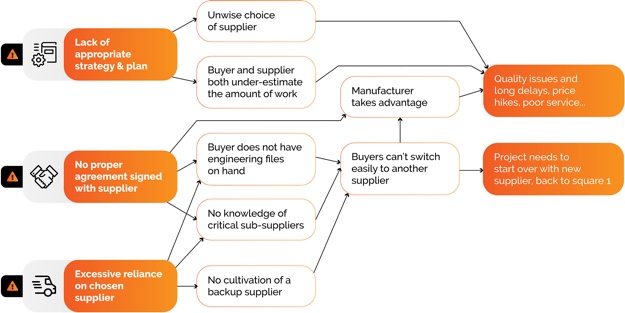
Deadly mistake 1:
No appropriate strategy & plan
This often leads companies into the hands of the wrong type of supplier. Here are a few examples:
- Working with an ODM manufacturer because they already have relatively similar products… with the risk of being their source of ideas for their own new products
- Working with a trading company that might not have much control over what happens at the factory
- Working with a large organization that will never put their best resources on your (tiny) project
- Working with a manufacturer that doesn’t even have the right engineering competencies
Many companies have come to us after getting frustrated by a bad-fit supplier. And we noticed that this original error was usually at the source of many other problems:
- Excessive confidence in one supplier, and lack of a backup supplier, which becomes a huge problem when the current relationship needs to be ended (as I will cover later). For anything but a small project, cultivating a backup is important. Even if you don’t get 100% production-ready, they should be at least halfway there.
- Ignorance of the wide gap between R&D (a few prototypes of the product made with components from random suppliers) and NPI (a certified product, ready tooling, ready production processes, ready testing stations, qualified suppliers, and the ability to transition from product development to mass production smoothly). Since it is ignored, it is overlooked… even though bridging this gap might take 6 months of hard work!!
- Since the buyer has no realistic vision of what it will take to get to a successful (i.e. mostly problem-free) mass production run, they make three serious mistakes:
- Trusting the supplier’s rosy projections (which often turn out to be massively over-enthusiastic) without requesting a specific plan and challenging it. Yes, sure, it can ship out in 4 months…
- Promising a go-to-market at an unrealistic date to eager retailers and/or crowdfunding backers, and delivering 6-18 months late!
- Promising a certain product to the market and to investors, before the product design is really mature. What if finally, you need to change a material to make it manufacturable at scale? Or a part of the software, to pass a certification?

- Another common trap for first-time buyers is their impression that a ‘sourcing agent’ will make the whole process easier. This is fine if the agent is paid for their work and they follow a certain process. This becomes a huge problem in these cases:
- The “agent” handles everything and blocks communication between the buyer and the manufacturer. This is a huge no-no. The buyer needs to learn from the process and see everything first-hand.
- The “agent” is paid a percentage of the number of orders. This incentivizes them to act as the supplier’s sales agent, rather than watching out for your interest. Why? Because they will have to keep the relationship going (even if the factory misbehaves badly) and get the orders shipped out (even if there are quality issues), in order to get paid.
Deadly mistake 2:
No proper agreement was signed at the start of the relationship
There’s so much to do when working out how to manufacture a product in China that a proper agreement is often set aside and forgotten… until the buyer starts to have doubts (or clear signs of misconduct). Make no mistake, though, it’s essential! Here are a few key benefits it would provide:
- Get the supplier to commit to keeping the bill of materials (i.e. the list of all components, with their sources and prices) open to you. If you request this from the beginning, some manufacturers will accept.
- Get the supplier to recognize that all intellectual property developed is yours. Yes, it should be “normal”, but in China, it is not…
- Have leverage in case the supplier misbehaves. This will apply if you make the agreement enforceable in the country of the supplier. I’ll suggest you read the beginning of this article on the China Law blog, as it points to many good resources on this topic. Many elements go into a good agreement.
The most important is to do this at the very start.
Once you have started working with a Chinese supplier, you have invested some time, and they have made some progress, they know you won’t switch away from them. Good luck to get them to sign your agreement at that stage… it is often too late.
What happens in this case? It doesn’t always happen, but the supplier might raise prices. Or they might deliver poor quality. Or they will take your tooling and/or products hostage when you start to threaten them with penalties.
These situations have killed thousands of new product manufacturing projects. Don’t be one of these casualties. The solution is well-known and applicable to your situation with a bit of adjustment.

Deadly mistake 3:
Excessive reliance on the chosen supplier
Since you tend to fall in love with a manufacturer and entrust your entire project to them, you fail to take any precautions.
(This is in addition to the absence of a proper agreement, and it compounds the effects I mentioned above.)
The most common symptoms of this mistake are as follows:
- The buyer has no knowledge of the critical component suppliers (or the factories doing critical surface treatment such as plating, painting, and so on). This makes switching to a new supplier even harder, as everything has to be started over from scratch.
- No (micro)management of the engineering work. The buyer doesn’t have the drawings, the schematics, and other non-recurring engineering deliverables. Again, moving away from the current supplier means starting over from scratch!
This is at the heart of what our company does, and many importers come to us for that kind of work. Unfortunately, when they realize how little information they have in their hands, and how bad their alternatives look, they sometimes decide that their only viable solution is trying to salvage their current supplier relationship…
This decision drives them to get even deeper into their hole. Sometimes they find a way to get some products to market and get some oxygen. Often, though, they are digging their own project’s grave. When they have run out of funds and there is no clear path ahead, it is often wiser to admit defeat.
Are YOU ‘China-ready’?
A friend told me once that many companies coming to Shenzhen or Shanghai to buy products are not “China-ready”.
Thousands of companies are formed every year to develop and make new products, they are not “China-ready”, and they have the confidence to go at it without proper advice and support.
This is like attempting to learn how to make a parachute after jumping from a plane. Buying off-the-shelf products can already be challenging. Developing a new product from scratch is orders of magnitude harder and riskier. Doing it without first spending time to understand the playbook about how to manufacture a product in China is really brave…

What are some signs that you may not be “China-ready”?
- You meet with a potential supplier and they go out of their way to make you feel welcome. The boss takes you out to a gorgeous dinner. You are impressed. However, all this is simply the standard way of making a sale in China. It does not mean they will treat you as a VIP customer all throughout the relationship.
- You feel confident about the factory. “They work for Microsoft” sounds good, but it means nothing until you have tangible proof of it. “They are on the Apple supplier list” is better and can be verified, but it won’t guarantee anything. I know this first-hand — we have seen a large and famous group working for Apple cheating small importers repeatedly.
- You make all sorts of assumptions that are very, very dangerous. I wrote a list of 21 common assumptions before, and here are a few examples:
- You think an NDA is an NDA, and you can use the template you have been using in your home country. Actually, it will be useless in China.
- You find Alibaba.com. You believe all the information you read there is truthful. You feel a “Gold Supplier” badge means they are safer than the others. All wrong.
- The manufacturer says they will make the tooling. You assume that tooling fabrication (and all the sensitive intellectual property that goes with it) will be done within their four walls. You assume it will be yours. You assume they will give it back to you if you ever request it. You assume they won’t use it for other customers. Think again!
- The supplier tells you they are moving their factory to a new location. You think it is like moving an office to a new building. At best, it is a serious disruption, causing their production to slow down significantly for 1 or 2 months (and that’s really optimistic). At worst, the factory is closing and they are subcontracting your production to a 10-person workshop in a garage, with no follow-up of quality.
Note that one should not generalize these observations.
Not all China-based manufacturers are unethical and incompetent — though many certainly are. Some are very good… and very busy, which means they are less likely to be interested in a small project requiring a lot of engineering work.
If you assume there is a high chance that a random supplier you meet is risky, you will take more precautions. That’s the right state of mind when operating in China.
And, to reduce this type of risk, the first step is to identify the type of “ideal supplier” you need to find. This brings me to the next point.
Element of solution 1:
Define an informed strategy and a realistic plan
Importers who are learning how to manufacture a product in China excitedly start devising their new product concept in a hurry to see it become reality, and at the same time they’re afraid of competitors getting to market before them. Is this you?
Beware of the ‘entrepreneur in a hurry’ syndrome. As I wrote above, you are about to explore quasi-uncharted territory. You need to gather some information first about what is expecting you. Don’t rush and find yourself in trouble you could (should) have avoided.
Think about all aspects and implications of your product design

What causes the most delays? Fixing issues too late in the process. Issues are 10 times more expensive in both money and time if you catch them in the middle of prototyping rather than in initial design, or in production rather than in prototyping.
Here are a few examples of important considerations that are often skipped early on, at great cost:
- Do you require a level of finishing similar to Apple’s products? Don’t pick a manufacturer that works mostly for Walmart.
- Will retail packages be stacked up? It means packaging needs to be strong enough.
- Will users expect the batteries to recharge fully in under 1 hour? This will have implications on the charger, the type of battery, etc.
- Will users expect to be able to replace parts? You need to make this operation easy and think of potential safety issues.
Spend some time planning your next steps
Keep Dwight Eisenhower’s famous quote ‘plans are useless, but planning is ‘indispensable’ in mind.
Have you been thinking of the different steps of your project, all the way to “the first batch has been manufactured and shipped out of China”?
People with no prior experience in product development systematically underestimate the time and effort needed. Here are two examples:
- Electronic design experts will tell you that at least 3 prototypes (for both the enclosure and electronics) will be needed. And each iteration takes time.
- If it is important that your product does not fail too early in the hands of its users, you will need to run highly accelerated lifetime testing (HALT). It is an extra cost, and you may need to wait for the results before confirming the product design.
This is why, last year, we suggested a roadmap for complex hardware products that are developed and made in China. It is not exactly optimistic, but it will get you thinking about what you might do right or wrong (and that’s the whole point). Work with people who have done it before, in order to adapt this plan to your specific situation.
Any milestones?
In your plan for how to manufacture a product in China, you will probably want to include milestones, and ideally a stage-gate approval process (to do a review before moving on to the next phase).
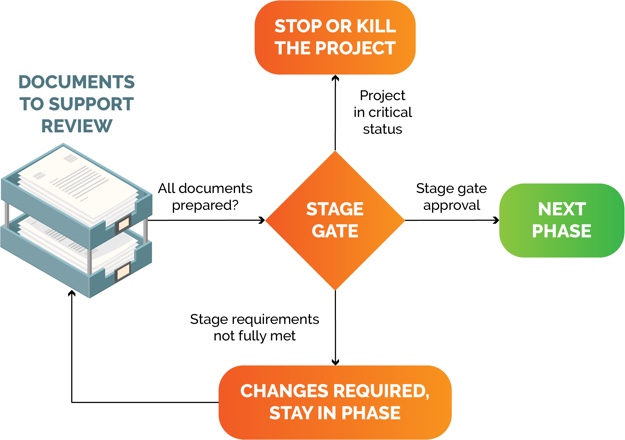
Note: this is common in established organizations and in certain startups that need to convince investors; it is usually not handled this formally in most newly-formed companies.
Here are examples of classic milestones:
- Confirm the industrial design (i.e. outside appearance of the product) is appealing to typical consumers (and/or retailers), before working on detailed 3D
- CAD drawings
- Confirm a look-alike prototype is appealing to typical consumers (and/or retailers)
- Confirm a ‘proof of concept’ prototype successfully performs 2 core functions
- Confirm a work-alike prototype meets desired specifications
- Get a third-party product certification to establish compliance with relevant regulations
In the consumer electronics business, new products are the lifeblood of companies. In the USA, particularly on the West Coast, they have defined that activity with relatively precise codes.
Here is a video overview of their new product introduction process:
Expect some delays
It is a sad reality that most projects are delivered late. And, the more complex the project, the more they tend to fall behind schedule. Many studies have shown this to be true.
We showed a typical example (where the project actually took twice as long as planned) in this article. Psychologists call this tendency the ‘planning fallacy‘. You will probably not escape it.
Take it into account when you prepare your financial projections — every fixed expense such as monthly salaries will make your overall costs balloon. Paying fees for services rendered, rather than employing full-time people, usually de-risks the project in that sense.
There are often solutions to save time… but they might come with high risks
Here are a few examples of time-saving moves:

I hope you have read the start of this article. The “3 deadly mistakes” I mentioned above are the pitfalls you absolutely need to avoid when learning how to manufacture a product in China.
You also need to know what the biggest risks, and assumptions, are in your project. Here are two examples.
- If you assume a particular technology can be used for the purpose you have in mind, and if that is quite uncertain, the very first thing to do is a proof of concept to address this assumption.
- If you see the risk of being copied as the highest risk, talk to a lawyer who works on intellectual property rights and is familiar with the Chinese business environment, before you talk to anybody else of your product idea. On the other hand, if you visit ten companies in Shenzhen without telling them what you need to make, that would be very unproductive.
In particular, spend some time reducing the market risk
As consultant Eric P Rose advises hardware startups, you should make sure there is a demand for your product, and you should understand the nuances of that demand before you invest a lot of money and energy in making that product a reality.
Research has shown that 42% of startups that fail, fail because they deliver something the market does not value. That’s actually the number 1 reason for startup failure!
In addition to market research, one way to keep the market risk limited is by developing a “minimum viable product” as version 1.0 of your product:
- Show virtual (computer designs only), physical ‘look-alike’, and physical ‘work-alike’ prototypes to your target users/buyers, to get feedback along the way and pivot if necessary
- Get to market faster with a simpler product, get real-life feedback, and make informed decisions about what should be in version 1.1… or 2.0!

What certifications will be needed in the countries of sale?
You need to know this from the start, and that may require a bit of research (with a service such as ComplianceGate.com, ProductIP.com, or others).
For example, many of the electronic products we have developed for our American clients require an FCC, and sometimes also a UL, certification. This has to be planned from the initial design stage:
- Placing components the wrong way on a PCB can cause a failure for FCC (doing design reviews & simulations has proven invaluable, in our experience);
- If you develop a power bank and retailers request that it is UL-certified, you are probably better off spending some time looking for a battery supplier that has already got that same UL certification.
- The certification needs to be done on pre-production prototypes after the tooling and nearly all the engineering work has been done. Redesigns at that stage can be expensive and time-consuming.
What type of factory should you work with?
A business learning how to manufacture a product in China needs to look for the type of supplier that will be a good fit for its needs. One way of categorizing suppliers is based on their business model:
- Original Design Manufacturer (ODM) — if you want to piggy-back on their existing technology, keep investment low, and be more of a distributor than the product owner. It comes with its own risks.
- Original Equipment Manufacturer (OEM) — if you don’t mind working in the “Chinese way” where the supplier hides some elements but subsidizes the product development. The OEM is specialized in the type of product you are buying.
- Contract Manufacturer (CM) — if you are ready to pay for the development and the tooling, and have a clear contract that gives you a lot of control and visibility. The assembler is more of a generalist, often working on different product categories.
Another way is by their size. I generally classify them into 3 broad levels:
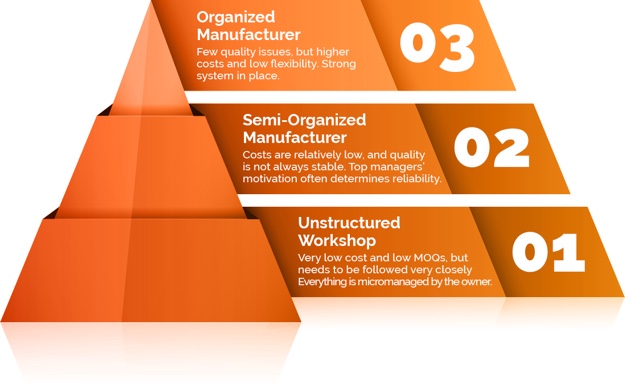
Smaller factories might be ‘light’ on engineering resources and on quality control. Larger organizations tend to be much slower and more expensive. Finding the ‘best match’ might take some work.
What is the most appropriate process for prototyping custom-designed parts (if any)? Conventional CNC machining, 3D printing, or more seldom used approaches such as stereolithography, selective laser sintering, or vacuum casting?
This information can drive your search for the best partner for initial prototyping. Typical Chinese factories usually don’t have such processes in house, but can help with later-stage prototypes. We’ll discuss this in more detail in ‘Element of solution 4‘.
Element of solution 2:
Structure your supply chain on a solid foundation
Your new electro-mechanical product may count tens of components. In many cases, what makes or breaks a development project is a succession of mistakes when setting up the supply chain. Here is how to avoid that.
(By the way, if you want to go deeper into this topic, I have written e-books on how to find and develop suppliers, and on how to verify suppliers.)
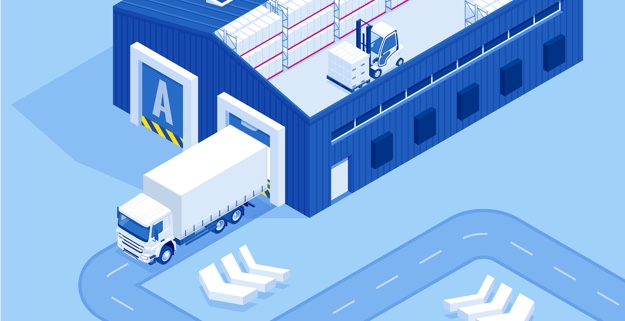
Identify, screen, and qualify suppliers
By now you have an ideal supplier type. There are probably thousands of options in your product category, so you need to screen them down.
First, make sure you are not dealing with a trading company pretending to own & operate a factory. A business registration check is simple and quick, and it can help you weed these out.
You also need to make sure they can do a good job when the time comes to ramp production volumes up. Do a process audit on one or two key factories. An engineer can visit them and look for risks in the most important areas.
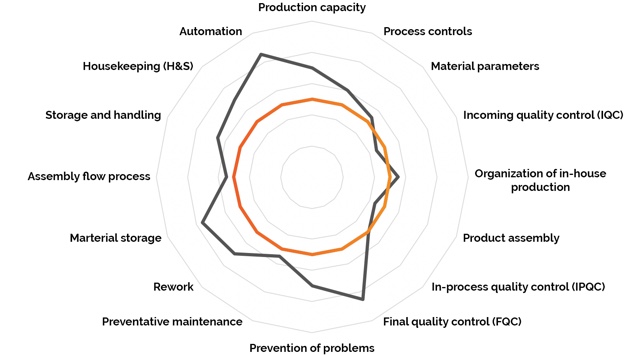
In-depth conversations, as well as astute observations, are also important. If the owner used to be a salesperson and has been re-investing his profits in real estate, these are usually not good signs.
Never let a middleman obscure visibility
Don’t let an assembly factory set up and “own” your entire supply chain. (We cover this in more depth in the next section.) If you do not know where the critical components come from, it will cause several issues in the mid-to-long run:
- If there are quality issues in one of the component suppliers, they might never be well resolved, and you won’t be able to send a good engineer there.
- You will have little idea of the margin made by your assembler. We have seen cases where it was in the 60% to 80% range.
- The assembler might raise prices and/or under-deliver, and you might have trouble rebuilding that supply chain. For example, you really want to keep the same anodizing effect on your product’s surface, but most anodizing workshops can’t reproduce it.
Don’t try to control every aspect of your supply chain
Some suppliers are critical, others aren’t. You don’t have unlimited resources. Let your manufacturer pick the suppliers of screws, connectors, etc.
However, you need to identify a few critical lines in the Bill of Materials (BOM):
- If a material is in contact with food, you will need to ensure its supplier is aware of regulatory requirements,
- If the casing is made of injection-molded plastic, you need that factory to be capable of delivering consistent quality,
- If glue is involved and might create serious issues, you will need the MSDS.
Have a backup for every critical supplier
This may not be possible when you develop your product and at the time of the first order. You need to think about it at some point, though.
It can also be useful if your order volumes pick up faster than expected — that’s a good problem to have, but still, a problem if your primary supplier cannot follow as quickly as needed.
Keep in mind that onboarding a new supplier takes time. If you wait until you need a backup, you might lose a lot of time.
Element of solution 3:
Set the right expectations from the start
One of the three key mistakes I outlined at the start of this guide on how to manufacture a product in China is the failure to set a proper agreement from the start with suppliers. It is actually more complicated than that since there is more than 1 document to prepare.
Also, documents and legal agreements are not sufficient. You will need to adopt the right strategy and make the right decisions.
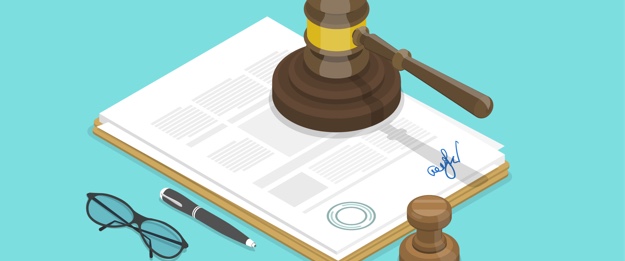
Clarifying your needs and your standard
First things first. Communicate your needs clearly! No Chinese supplier will be able to guess what your product users need or require, as well as you do.
Start drafting a product specification sheet (including tolerances wherever possible). It will be very useful at all levels — for engineers working on prototypes, for purchasers, for the manufacturing staff, and for all the inspectors along the process.
Once a look-alike and a works-alike prototype is approved, it must be catalogued as part of your standard. Once a pre-production prototype (with parts coming off the tooling made for production) is approved, it will become the new standard. And so on.
Strategies for maintaining confidentiality
Once your product is on the market and is successful, it is likely to be copied by Chinese companies (whether it is made in China or not) and fighting them might be very difficult. Before that, though, there are ways to reduce the risk of being copied. Here are 4 classic strategies.
Have a lawyer draft a non-disclosure, non-use, and non-circumvention (NNN) agreement that is applicable in a Chinese court, and have every Chinese supplier sign it before you disclose anything confidential to them.
When you contact and screen potential suppliers, show them a part or product that is different from yours but requires similar processes. Then, only show your product to the 1 or 2 ‘best fits’.
Make sure to check your potential suppliers on these two dimensions:
- Nature of business: are they a trading company that will necessarily send your IP to outside factories? Once it is sent outside of their organization, there is usually no way to control it.
- Internal engineering competencies: can they work on design & engineering themselves, or will they need to collaborate with outside parties?
Avoid raising money on Kickstarter and Indiegogo too early in your project, because some unscrupulous companies might even re-use the photos you prepared as part of their marketing materials!

Compartmentalizing the supply chain (the ‘black box’ concept)
In China, some buyers have had a particularly nasty surprise: a bad actor in their own supply chain noticed the product’s success and decided to take advantage of it by making extra quantities and selling in competing channels.
It is particularly destructive because they might beat you to the market when you develop your version 2.0 if they have sufficient information about it.
In order to avoid this situation down the road, we have set up this approach for several clients:
- We buy components from various suppliers, who are never given the full picture and don’t even know what the end product does, in what distribution channels it is sold, what brand it is sold under, etc.
- We manage final assembly (including testing & packing) and shipping, and every party involved is kept in the dark.
Development & manufacturing agreement(s)
Companies learning how to manufacture a product in China who choose to develop a new product with their new supplier very often forget to specify their requirements in these two areas:
Negotiating all this is usually straightforward when working with a contract manufacturer, might be difficult with an OEM, and is always very convoluted (or outright impossible) with an ODM.
Quality verification & validation plan for prototypes
If no testing plan is documented for your product, how will the engineers working on prototypes be able to know if they have done a good job?
For example, you’ll want to test your prototypes:
- For compliance (safety, battery cells…)
- For performance, including stress testing
- For robustness
- For all important features
(As you document this plan, and as you update it, make sure its content ends up in the specification sheet we mentioned above.)
Pushing the product to its limits
You are also advised to plan for functional testing outside of ‘normal’ use.
For example, we worked on the development of a battery-powered skateboard. We did tests on smooth roads, but also on dirt roads, on slopes, with a very heavy user, and so forth. Basically, don’t limit yourself to the optimal operating window (shown in green below):
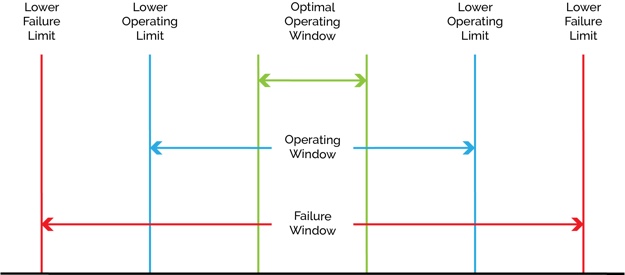
The same logic can be applied by a reliability testing laboratory. You don’t have to set all this up by yourself.
All the results you gather this way will inform you of the limits of the product as it is designed. And you might decide on design improvements.
Tooling and other non-recurring engineering (NRE) investments
Spend time planning before giving the green light on these types of investments. Buyers tend to trust their suppliers way too much at this point.
For example, for plastic injection molding, how many shots will the mold allow you to make? The type of steel used will make a large difference — for example, a mold made in P20 steel might start to require a lot of rework after 40,000 shots, while H13 steel might be good for 1 million shots.
The harder, and more durable, steel is harder to machine. The tooling takes more time and is more costly. But it might be just what you need. You need to understand and specify all this.
Pilot runs before mass production
I have already mentioned this, but it is worth repeating:
- Some of the components are custom-made — have these components’ suppliers do a small batch and count how many pieces are ‘good the first time’. If the proportion is under 90%, you are exposed to sharp and sudden price increases.
- Your product is new for the assembly workshop, too. Ideally, they have prepared some custom tooling for assembly and for testing. A small run on the assembly lines is the best way to confirm the processes are ready. The more complicated and new the product is, the more issues will be discovered this way.
Quality monitoring of production
You approved a prototype, you feel the R&D engineers know what you want… but what about the production and quality staff? Be there if you can during the first mass production batch. Observe their own quality control processes.
Now, do not think inspectors will fix all your issues. They only detect problems — ideally at the source, but often hours or days later. The key, once your scale volumes up, will be having the manufacturer set up and fine-tune the right process controls.
When the time comes for the second or third batch, do not expect the production ramp-up to be smooth. With Chinese assemblers, there are often long delays, as I described before.
Element of solution 4:
Get the design and engineering right
Let’s say you followed all the advice I laid out above because you want to know how to manufacture a product in China successfully. You have a strong plan and a good idea of what to do. You have found and qualified the right suppliers. You have clarified all the right requirements and got written agreements.
You still need to keep control of technical aspects. Getting competent and experienced people focused on your project and working on the right things is not easy.
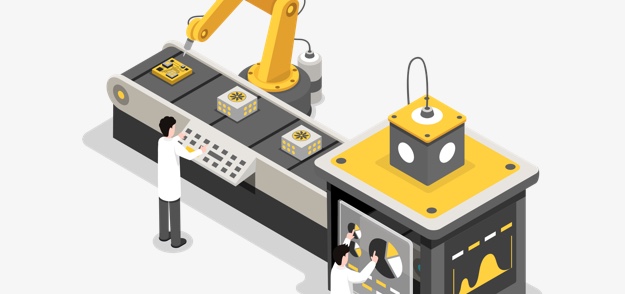
Don’t go to a Chinese manufacturer too early
Some people don’t spend sufficient time working on their product design, and they hand an immature design to a manufacturer. This is usually misguided for a few reasons:
- A manufacturer makes money when it purchases materials, transforms them (in a ‘mass-production’ batch), ships them out, and gets paid. Expect them to keep their best people busy with those activities.
- Chinese companies tend to live in the short term. You might be able to “sell” your project to them and get a few good engineers working on your new product development, but they might be reassigned to other pressing issues 3 months later after you sent a long list of improvements needed on their second prototype. After that, the project might crawl to a halt, or keep going at a glacial pace.
- They are experts at operational procurement and manufacturing, and they are generally weak at evaluating what materials would make the most sense, sourcing new suppliers, and so on. It means they will not provide all the assistance you need to make a great product or simply to fix the problems you run into.
In other words, work with a design firm and with a supply chain management firm until you are at the point where you can bring a mature design to a manufacturer. It will be faster and they will give you better work quality. (And there is a price for it, obviously.)
Work with people who have already done it before
Your product is unique. It comes with its own challenges. Don’t work with engineers who are trying to figure out how to use CAD software, or what protocols to use, otherwise design & development will drag on for a long time!
There is usually a logical process to follow (example below).
PCB logical design process
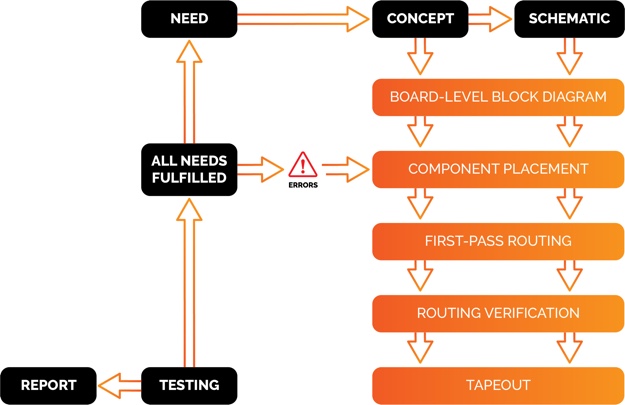
Designers and engineers should be able to explain it to you. If they can’t give you examples of similar projects, as well as the usual steps to follow, it is a sign that you are about to work with the wrong people.
DFM (Design for Manufacturing)
The more unique your product, the more vital good DFM suggestions will be for entrepreneurs and SMES who’re wondering how to manufacture a product in China. Any improvements done at the design stage will take much less time and money than in subsequent stages.
A part of this analysis can be reduced to a checklist — here are a few examples:
- Can we reduce the number of components?
- Can we find ways to simplify the design and cut costs?
- Can we make assembly easier, so as to improve both efficiency and quality?
- What materials would be the most appropriate?
- How to miniaturize certain elements?
In addition, a good designer or engineer can review your product design and will usually have a number of questions and remarks, simply by pulling from their past experiences interacting with Chinese manufacturers.
Prevent design-related defects
Most quality issues found in the field come either from design or manufacturing. Poor design can cause many problems that might only appear after 6 or 12 months of use.
The more robust the design is, the less likely you are to experience quality issues down the road. But what makes a robust design? It simply means it will be more forgiving of variations in the manufacturing conditions, and defects will be less likely to appear.
Let’s say a critical operation relies on a physical and/or chemical process. There is always an optimal operating window (in green below). For example, the parameters might be pressure and temperature, in an injection molding press.
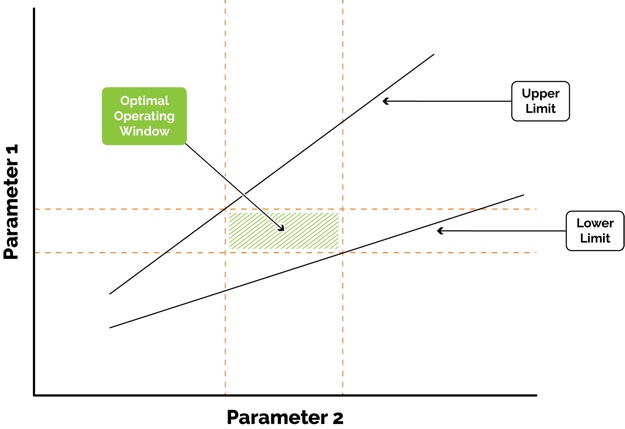
If the optimal operating window is tiny, small variations (which might be unavoidable) will result in quality issues. And, if the manufacturer identifies this phenomenon, they will not take responsibility when you come back to them with customer complaints.
Manufacturing and testing processes
You need to design your product, give it shape (prototypes), and test it. At the same time, someone also needs to start designing the process and testing it.
We have seen buyers push their manufacturers to hurry up, to the point where they started assembling products without having thought of the assembly steps, without training operators, and without preparing any inspection/testing process. These are the cases where everything goes wrong, and shipments end up being very late.
How to avoid being in such a hurry that important preparation steps are skipped? Start to work on it at the same time the final prototypes are being validated and the tooling is made. It takes a bit of planning and coordination, but it is worth the extra work.
These are just a few of the many considerations you need to keep in mind when it comes to the design and engineering work, which will shape the final product’s cost, quality, and success in the marketplace. Once again, make sure to work with experienced people and allocate the right resources.
![How To Manufacture A Product In China [Importer's Guide] conclusion How To Manufacture A Product In China [Importer's Guide] conclusion](https://qualityinspection.org/wp-content/uploads/2020/01/img-11.jpg)
Conclusion
Many people who come to us asking about how to manufacture a product in China are worried, and they say “new product development is messy, and we never know where it is going”. I will say this is very true if you don’t work hard on planning and if you place an untested manufacturer in charge of all the development work.
Your product is new, and you will have to handle associated risks (technical choices, market acceptance…). Make sure you don’t add extra risks to the mix.
Three years from now, when you have successfully brought your innovative product to market and you are working on its second (or third) version, you will need to repeat this process. You will probably decide to simplify certain aspects of the design and spend more engineering time in one crucial area. You will probably take measures to prevent certain risks, and spend time planning your next steps. You might even switch to a more suitable type of factory.
Ideally, you will get all this (mostly) right the first time you embark upon a new product manufacturing project. It was this guide’s objective. Hang on — it will probably be a long journey. And let me know how it goes.
P.S. Keep reading more content to help you learn how to manufacture a product in China
If you still want even more information on how to manufacture a product in China successfully, try these resources:
- New Product Launch Tips For Entrepreneurs (Q&A with Liz Long of ‘Learn to Make a Product’)
- What’s The Investment Required To Bring My New Product To Market?
- New Product Launch: Taking Shortcuts vs. Preventing Risks
- Dangers of Amortizing Development Costs in the Production Price
- From New Product Design to Production: What Is on the Customer’s Plate?
- Ultimate Guide To Sourcing From China And Developing Your Suppliers [eBook]
- IP Protection in China when Developing Your New Product [Importer’s Guide]

![Download How To Manufacture A Product In China? [Importer's Guide] Download How To Manufacture A Product In China? [Importer's Guide]](https://qualityinspection.org/wp-content/uploads/2020/01/cta.png)